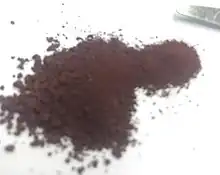 | |
 | |
| Names | |
|---|---|
| IUPAC name
disodium tetrachloropalladium(2+) | |
| Other names
disodium tetrachloropalladate(II) | |
| Identifiers | |
3D model (JSmol) |
|
| ChEBI | |
| ChemSpider | |
| ECHA InfoCard | 100.034.079 |
| EC Number |
|
PubChem CID |
|
CompTox Dashboard (EPA) |
|
| |
| |
| Properties | |
| Cl4Na2Pd | |
| Molar mass | 294.20 g·mol−1 |
| Hazards | |
| GHS labelling: | |
    | |
| Danger | |
| H290, H301, H302, H317, H318, H319, H410 | |
| P234, P261, P264, P270, P272, P273, P280, P301+P310, P301+P312, P302+P352, P305+P351+P338, P310, P321, P330, P333+P313, P337+P313, P363, P390, P391, P404, P405, P501 | |
Except where otherwise noted, data are given for materials in their standard state (at 25 °C [77 °F], 100 kPa).
Infobox references | |
Sodium tetrachloropalladate is an inorganic compound with the chemical formula Na2PdCl4. This salt, and the analogous alkali metal salts of the form M2PdCl4, may be prepared simply by reacting palladium(II) chloride with the appropriate alkali metal chloride in aqueous solution.[1] Palladium(II) chloride is insoluble in water, whereas the product dissolves:
- PdCl2 + 2 MCl → M2PdCl4
The compound crystallizes from water as trihydrate (Na2PdCl4·3H2O, reddish-brown powder with molar mass 348.22), which is the commercially available form.[2]
This compound may further react with phosphines to give phosphine complexes of palladium.
An alternative method of preparing such phosphine complexes is to break up the coordination polymer of palladium(II) chloride into reactive, monomeric acetonitrile or benzonitrile complexes,[3] followed by reaction with phosphines.[1]
References
- 1 2 Daniele Choueiry and Ei-ichi Negishi (2002). "II.2.3 Pd(0) and Pd(II) Complexes Containing Phosphorus and Other Group 15 Atom Ligands" (Google Books excerpt). In Ei-ichi Negishi (ed.). Handbook of Organopalladium Chemistry for Organic Synthesis. John Wiley & Sons, Inc. ISBN 0-471-31506-0.
- ↑ The compound's page in Strem Chemicals catalog
- ↑ Gordon K. Anderson, Minren Lin (1990). "Bis(Benzonitrile)Dichloro Complexes of Palladium and Platinum". Inorganic Syntheses. Inorganic Syntheses. Vol. 28. pp. 60–63. doi:10.1002/9780470132593.ch13. ISBN 9780470132593.